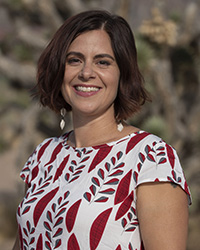A Question of Criminal Procedure
SCOTUS has opened the door for states to prosecute certain crimes on Indian land. Boyd Law professor and federal Indian law scholar Addie Rolnick considers the potential consequences

By Matt Jacob
One U.S. Supreme Court case that mostly flew under the mainstream media’s radar was nonetheless significant to legal scholars whose work focuses on Native American sovereignty—scholars such as Addie Rolnick, the Yuhaaviatam of San Manuel Nation Professor of Law at the William S. Boyd School of Law at UNLV.
Having written and taught extensively about indigenous rights and justice systems, Rolnick kept a close eye on Oklahoma v. Castro-Huerta, the case that considered whether states had jurisdiction to prosecute non-Indians who commit crimes against Indian people on tribal lands.
The court in late June ruled 5-4 in favor of Oklahoma. With the decision, the court blurred an almost 200-year-old sovereignty line that had largely kept states from prosecuting crimes committed on reservations—crimes that have long been prosecuted primarily by tribal and federal officials.
“Criminal jurisdiction in Indian country has always been a complicated maze,” says Rolnick, who also directs Boyd Law’s Indian Nations Gaming & Governance Program. “But one category of crime we all have long known to have no gray area is when a non-Indian person commits a crime on a reservation against a victim who is Indian—a so-called ‘interracial’ crime. That had always fallen under federal jurisdiction. This case changed that by saying states also can have jurisdiction over those [types of] crimes.”
Rolnick acknowledges that the scope of the decision is limited in that it only affects a small category of crimes. Tribal jurisdiction over crimes committed by non-Indians was already limited by a 1978 case, so the ruling in Oklahoma v. Castro-Huerta does not directly undercut tribal jurisdiction in most instances. States, for example, still can’t claim jurisdiction when a crime committed on a reservation involves an Indian defendant and an Indian victim. Nor can states get involved if an Indian person perpetrates a crime against a non-Indian on tribal land.
Still, she says the ruling’s implications could be significant, because it potentially adds another player to the criminal justice mix regarding jurisdiction on Native land.
“The decision allows states to run into Indian country and exert some jurisdiction over a new category of crimes that they didn’t previously have,” Rolnick says. “It’s also possible that in individual cases where the state has jurisdiction and another government—be it tribal or federal—does, too, the state can decide to press forward no matter what the other government entity wants to do.” This could be especially important for tribes exercising “special domestic violence” jurisdiction over non-Indians, as authorized by two recent federal laws.
More importantly, in reinterpreting longstanding precedent that limited state criminal authority in Indian country, SCOTUS opened a door that could lead to a greater trampling of Native American sovereignty. While tribal government leaders are still permitted to establish rules and regulations that govern their land, state prosecutors now can intercede when a non-Indian commits an act that violates state law but is legal under tribal law.
“Tribes can have their own regulations about a lot of things that might differ from state law—things like gaming or marijuana use,” Rolnick says. “Now, states can use this new criminal jurisdiction as a way to go after tribal regulatory authority. I don’t know that state prosecutors will do that. But it’s possible.”
Translation: It could take years before tribal councils and scholars such as Rolnick learn the true impact of this landmark SCOTUS ruling.
“If it turns out that states limit the way they implement it—and the court doesn’t try to expand the scope beyond this decision—the practical effect could be minimal,” Rolnick says. “But there’s a potential for undermining the criminal justice priorities of both the federal government and tribal governments, because we’re letting states come in and do more inside reservations than they’ve ever been allowed to do.”